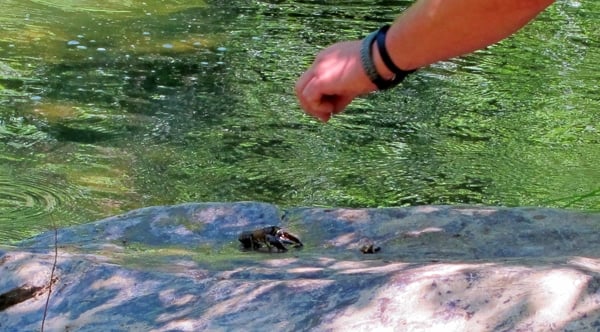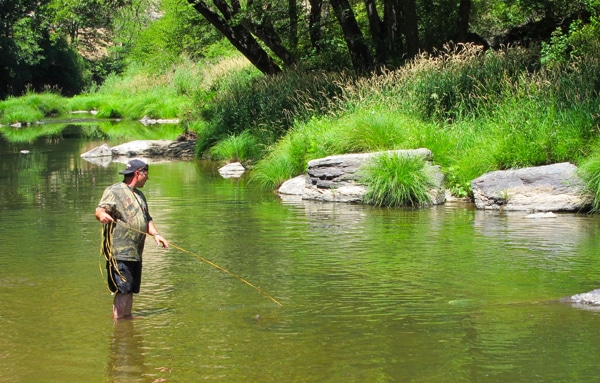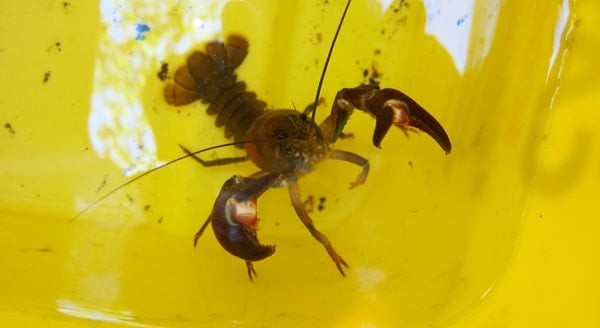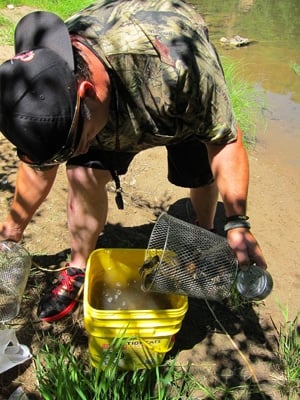As an Amazon Associate I earn from qualifying purchases.

The older I get, the more the cares of the world weigh on me. My body is not so strong as it once was, and I find myself spending more time than I probably ought to worrying about things like paying the mortgage, earning a living and doing some good in this world before my turn on its stage comes to an end. So when I stumble into a moment of unalloyed childish joy, I savor each instant while I can.
Last week I had such a moment, catching crayfish from a stream in the High Sierra.
My friend Mark had offered to take me up to one of his spots in the Plumas National Forest, near Buck Lake. This was a part of the Sierra I’d not yet seen, but for Mark, who used to live in nearby Quincy, it is a second home. Ostensibly we were up there to catch trout, but I was far more excited about catching crayfish. Turns out so was Mark.
Mark had been to this stream a week before with his girlfriend Misty, and they had scored big. “Some of the traps were stuffed!” he said. We’re both fans of the TV show “The Deadliest Catch,” so as we drove, we made all kinds of references to “riders” (crayfish not trapped, but riding on the outside of the pot), “setting back” (returning the pot to where it had initially caught lots of crayfish) and, jokingly, “grinding” (working 24-48 hours straight catching crayfish). Visions of etouffee danced in my head.
Still, I am always skeptical about reports of plenty. Gathering food in the wild is a fickle affair: Being in the right place at precisely the right time can make all the difference in the world, and what happened yesterday will not necessarily repeat itself today. If I had a dollar for every time someone said, “Aw, man! You should have been here yesterday!” I’d buy myself a new truck. Mark was talking a big game as we drove up the mountain.
He’d brought three traps to set. A crayfish trap is a wire mesh cylinder that comes apart at the center. Bait goes inside the cylinder, which then latches closed. Crayfish can get in through wire tunnels on each end — but those tunnels make it very tough for the little lobsters to find their way back out. Mark’s bait of choice: cat food in steel cans, which we perforated with our pocket knives.

We arrived at Mark’s spot. It was a stretch of stream like any other in the Sierra. There was nothing at all that suggested it might hold a crawdad bonanza. Mark tossed the traps in the center of the stream, then flipped a perforated cat food can a couple feet into the water, near where we’d sit and wait for the traps to fill. “I want to watch them eat it,” Mark said.
Mark broke out some tri-tip sandwiches. No more than a few bites in, the magic started happening. From every rock and crevice, crayfish crept out and scuttled toward the cat food can. I’d never seen anything like it. All of them had a little white patch at the crook of their claw — that meant these were Pacifastacus leniusculus, the signal crayfish. An alien invader.
Signal crayfish are native to the Pacific Northwest, but not California. State Dept. of Fish & Game scientists brought them here in 1912 to see whether they eat baby trout. They do, although like most crayfish, they are mostly vegetarian. When the study was over, for some inexplicable reason the scientists dumped the crawdads into Santa Cruz’s San Lorenzo River. They’ve spread all over the state since then.
Mark and I sat mesmerized by all the crayfish attacking the cat food can. “I bet we could catch some by hand,” I said. I stuck a hunk of tri-tip to the end of one of my trout lures and lowered it into the stream, right in front of a crawdad. It immediately clutched the meat between its claws and started eating it. I gently pulled on the lure, tugging the crayfish closer to the bank. He kept on eating, oblivious. Closer, closer… When I’d pulled him as far as I could without getting his head out of the water — they let go if that happens — I flicked the lure toward shore.
The crayfish let go a few inches from the bank. As quickly as I could, I snatched him from the water and tossed him into our bucket. Schweet! Mark and I began catching crayfish by hand, one after another.

I was a boy again, hunting crayfish in the creeks that fed into Echo Lake, a park near my house in Westfield, New Jersey. My friends Lowell and Chris and Mike and I would spend hours at Echo Lake Park, mostly riding around in canoes or paddle boats, where we would have splash fights on the lake. We would walk the three miles each way to the park unattended by grown-ups; each trip was a little adventure. We’d “provision” at 7-Eleven and, armed with pretzels and candy and Slurpies, make our way to the lake. It was great fun.
Catching crayfish in the little streams was a matter of dexterity. I would lift up rocks to find them, then cup one hand behind the crayfish while waving my other hand in front of his claws. He’d flip his tail to get away, right into my cupped hand. I could catch dozens this way. And yes, I got pinched more than a few times.

Mark and I were catching more than dozens. We were catching scores of crayfish by hand. At one point Mark realized this must be happening in the traps, too. So he started pulling them after less than an hour’s soak. It was just as he’d promised: They were stuffed, with riders on the outside of the cage and everything!
He emptied them into our bucket and set them back. We were both grinning like idiots. So much fun! In the end we came away with 189 crayfish, all caught in less than three hours. And we’d caught close to 60 by hand.
Mark and I have each seen more than 40 summers, and it’s been a powerful long time since we were boys chasing crayfish in our secret spots, a continent apart. But for one magic afternoon we were given the chance to relive that joy. We won’t soon forget it.




Sounds like a good day! I used to catch them by hand too, but we’d always just throw them back. Only ever eaten them in at the Crawdad Festival in Isleton. Maybe I need to try catching again this summer…
@Chris Hobart-rainbow trout are definitely native to CA, not invasive!
Always used hot dogs, heh. Growing up in Truckee we used to trap on Lake Tahoe and Donner Lake, or at my grandfather’s house on Lake Almanor. Even though they’re invasive (just like Mackinaw, rainbow, Brown, and Brook trout) they were a great part of growing up in the mountains.
People can claim that all those “hotdogs” and “bacon” and such works the best but you have to wonder what crawdads eat most of the time.. and it’s fish. You can’t wrong with some dead sucker minnows in there. Bait stores usually give them away for free if you talk to the employee when it comes time to clean out his tanks. The bigger the better too. My neighbor also claims that he has the best luck with chicken guts… hmmm. I dig your images here on this post. You must have a camera on a tripod.
Thanks for the kick in the pants. I got out my trusty old crawdad trap and last night caught 60+ in three hours soak.
Olive season coming soon too. Thanks again.
Describe the flavour. I’ve had some before that were a little muddy tasting. I’d imagine these’d be delicious coming from a mountain stream!
Hank,
This post was fun to read. It brought back such fond memories!
We caught crawfish, using old hot dogs, out of Stevens Creek in Cupertino on our way to and from the pool in the summer. We’d also catch them from the Big Basin area when camping each Memorial Day.
Never did we have such success, though. Our big catch was ten! I’ll remember to tell my son to try punctured cat food cans when he’s old enough to give it a try.
Thanks for sharing. Neat picture of the crawfish in yellow, too.
We used to catch them with little bits of bacon out of Sonoma creek in Sonoma, CA when I was a kid. we’d get them by the bucketload. Thanks for reminding me of a more peaceful time.
We used to catch crayfish with hook and line in a stream behind my house in Honolulu. Brought home a huge bucket load one time and spent a lovely afternoon cleaning, then wok-frying, then eating the little buggers.
They tasted great. Thanks for sparking a taste memory!
Hank, you research stuff pretty darn carefully, but I wonder if you are right about crays not being native to California. I knew the man, for example, who in 1908 carted a bunch of them from Ross, in Marin County, to the west shore of Lake Tahoe. That was four years before your stated date of their release from that experiment. And how could they populate all the watercourses all over northern CA as they do? Did they go overland by themselves?
Those critters are now so numerous in Tahoe that someone just got all the permitting needed to start fishing them commercially, the catch going to the kitchens of Harrah’s Culb in Reno, I think.
We used to snorkel them at Tahoe, grabbing from behind the carapace, but still getting nipped at times. What fun, you are right
WOW! I almost sold my crawdad trap a few weeks ago due to the fact that I had not used it in some 12+ years… I’m going out today for the first “‘dads” in some time… Thanks for the story!
Great story! I grew up in Green Brook, NJ, about 10 minutes from Westfield. Just the other day I was telling my 8yr old daughter how I used to catch crayfish in NJ when I was a boy. She thought it was the most amazing thing. Now she does it on her Grandma’s farm in Indiana. The torch has passed. Thanks for memories!
P.S. You probably want to use different resampling options for downscaling the first image. Not sure what you used in CS4 but I suggest to try one of the bicubic options.
Last fall camping on a High Sierra lake the weather started to turn and wind and rain arrived. Lots of crayfish made it into the shallow, searching for food. Like you I caught about 30 on a rod and hat tails and claws for dinner. The next day you couldn’t tell that there were any crayfish in the clear lake…
The Boy and I just pulled in a 10 or so pound hall from Donner Lake this week using canned cat food and traps. Had a Donner Party Crawfish Boil CA style using some mismatched beers, bay leaves, thyme, serano’s, onion, taters and fresh white corn w/a healthy helping of Old Bay in one big pot. Everytime we’d pull up a pot the boy would do a Crawfish Dance on the dock. Good times!
I would use chicken livers to catch crawdads in the San Joaquin River, then use the crayfish as bait to catch catfish from the bank. Worked like a charm every time. One of my fondest memories came at a swimming hole near Oakdale. My brother promised me a rope swing into the river, and he delivered. I came to find out that in this particular spot — it was very deep. There was a wide hole in the bottom of the river. Being the curious chap that I was, I wanted to see what was down there, I dove as far as I could into that hole and waited for the murkiness to clear. There, in this hole, sat nature’s shelving at every level. And, on every shelf, sat the most giant crawdads I’d ever seen. Some must have been a foot and a half long. Needless to say, they terrified me! Those claws were huge! That was the end of “swinging on the rope” fun for that day. Thank goodness I didn’t break my neck like so many others did on those haphazardly set up rope swings.
Loved that post, thank you. When I lived in England, American signal crayfish were a popular haul of what is a pest there. Here in Australia, we have a few different species, but pretty much anywhere you go, one ‘yabby’ or another fills many people’s childhood memories. Mine is as a 7 year old snorkelling in a clear water river, spearing them with a kitchen fork – sounds unsporting now, but you know what they say boys will be.
My take on our version here: https://foragersyear.wordpress.com/2012/03/21/yabby-cherax-destructor/
That was a great read, thank you! We have Signals in the UK but not in the south west so I’ve never had the pleasure. Boy would I love to though!
Thanks for the memories, Hank! I used to spend my childhood summer vacations catching crayfish on a hooked worm in Ontario, Canada. I’d flick them onto shore and scoop them into a minnow pail with the cottage kitchen utensils. After releasing them, they were much smarter and more difficult to catch the following day. This only made it more fun.
I think these are the crayfish I’d catch on Vancouver Island. I’d throw salmon guts into a back eddy in the evening and then pick them up when they came out to feed. I filled a grocery bag. It was a lot of fun.
Why thank you sir! That was a joy to read and seemed almost a direct response to my question in the catfish comments. Brings back a lot of childhood memories of my own: turning over rocks in a little creek in Charlotte, N.C. I’m planning on setting a couple of traps down on a lake in Missouri next week and can only hope I’ll have as much luck as you did there.